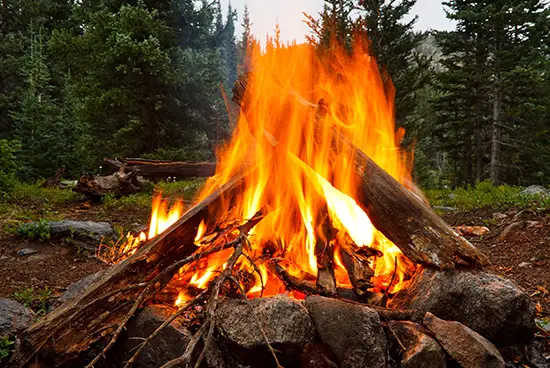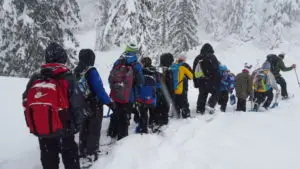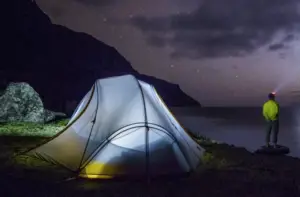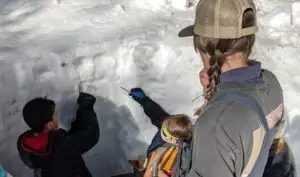 There’s something about that ubiquitous campfire. It just draws us in, and there is nothing like sharing tall tales, kinship and laughter around a campfire. That said, campfires also have their drawbacks, especially when they are misused. In fact, campfires can scar and sterilize the ground, and their remnants can be left behind for thousands of years. Not to mention – wildfires. The reality – as many as 90 percent of wildfires are caused by humans.
There’s something about that ubiquitous campfire. It just draws us in, and there is nothing like sharing tall tales, kinship and laughter around a campfire. That said, campfires also have their drawbacks, especially when they are misused. In fact, campfires can scar and sterilize the ground, and their remnants can be left behind for thousands of years. Not to mention – wildfires. The reality – as many as 90 percent of wildfires are caused by humans.
This summer is of special importance as we enter a significant drought for much of the Pacific Northwest and other parts of the country. In fact, our fire season is definitely going to be one worth noting as the current conditions are showing us (see the USGS figure below to see how dry it is). So what can we do about it? Simple. Follow Leave No Trace Principle #5 from our partners at the Leave No Trace Center for Outdoor Ethics.
Fires vs. Stoves: The use of campfires, once a necessity for cooking and warmth, is steeped in history and tradition. Some people would not think of camping without a campfire. Campfire building is also an important skill for every camper. Yet, the natural appearance of many areas has been degraded by the overuse of fires and an increasing demand for firewood. The development of light weight efficient camp stoves has encouraged a shift away from the traditional fire. Stoves have be come essential equipment for minimum-impact camping. They are fast, flexible, and eliminate firewood availability as a concern in campsite selection. Stoves operate in almost any weather condition, and they Leave No Trace.
Should I build a fire?
- The most important consideration to be made when deciding to use a fire is the potential damage to the backcountry.
- What is the fire danger for the time of year and the location you have selected? n Are there administrative restrictions from the agency that administers the area?
- Is there sufficient wood so its removal will not be noticeable?
- Does the harshness of alpine and desert growing conditions for trees and shrubs mean that the regeneration of wood sources cannot keep pace with the demand for firewood?
- Do group members possess the skill to build a campfire that will Leave No Trace?
Lessing the impact when campfires are used.
Camp in areas where wood is abundant if building a fire. Choose not to have a fire in areas where there is little wood at higher elevations, in heavily used areas, or in desert settings. A true Leave No Trace fire shows no evidence of having been constructed.
What about existing fire rings?
The best place to build a fire is within an existing fire ring in a well-placed campsite. Keep the fire small and burning only for the time you are using it. Allow wood to burn completely to ash. Put out fires with water, not dirt. Dirt may not completely extinguish the fire. Avoid building fires next to rock out crops where the black scars will remain for many years.
What exactly is a mound fire?
Construction of a mound fire can be accomplished by using simple tools: a garden trowel, large stuff sack and a ground cloth or plastic garbage bag.
Follow the simple steps below:
- Collect some mineral soil, sand, or gravel from an already disturbed source. The root hole of a toppled tree is one such source.
- Lay a ground cloth on the fire site and then spread the soil into a circular, flat-topped mound at least 3 to 5 inches thick. The thickness of the mound is critical to insulate the ground below from the heat of the fire. The ground cloth or garbage bag is important only in that it makes cleaning up the fire much easier. The circumference of the mound should be larger than the size of the fire to allow for the spreading of coals. The advantage of the mound fire is that it can be built on flat exposed rock or on an organic surface such as litter, duff or grass.
What about a fire pan?
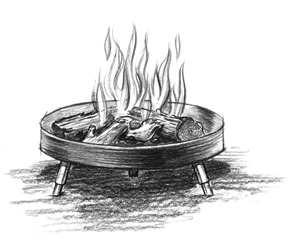
Use of a fire pan is a good alternative for fire building. Metal oil drain pans and some backyard barbecue grills make effective and inexpensive fire pans. The pan should have at least three-inch-high sides. It should be elevated on rocks or lined with mineral soil so the heat does not scorch the ground.
What about firewood and clean-up?
Standing trees, dead or alive, are home to birds and insects, so leave them intact. Fallen trees also provide bird and animal shelter, increase water holding capacity of the soil, and recycle nutrients back into the environment through decomposition. Stripping branches from standing or fallen trees also detracts from an area’s natural appearance.
- Avoid using hatchets, saws, or breaking branches off standing or downed trees. Dead and down wood burns easily, is easy to collect and leaves less impact.
- Use small pieces of wood no larger than the diameter of an adult wrist that can be broken with your hands.
- Gather wood over a wide area away from camp. Use dry drift wood on rivers and sea shores.
- Don’t bring firewood from home. Either buy it from a local source or gather it responsibly where allowed.
- Burn all wood to white ash, grind small coals to ash between your gloved hands, thoroughly soak with water, and scatter the remains over a large area away from camp. Ashes may have to be packed out in river corridors.
- Replace soil where you found it when cleaning up a mound or pan fire.
- Scatter unused wood to keep the area as natural looking as possible.
- Pack out any campfire litter. Plastic items and foil-lined wrappers should never be burned in a camp fire.
Fire Safety
- Provide adequate supervision for young people when using stoves or fires.
- Follow all product and safety labels for stoves.
- Use approved containers for fuel.
- Never leave a fire unattended.
- Keep wood and other fuel sources away from fire.
- Thoroughly extinguish all fires.
Taken from www.lnt.org. See more at: https://lnt.org/learn/principle-5#sthash.4DbzezMB.dpuf
Join me on Saturday June 13th for a Leave No Trace Awareness Workshop or later this summer for a Leave No Trace Trainer Workshop!
Dennison Webb, M.A.
Founder | Executive Director

